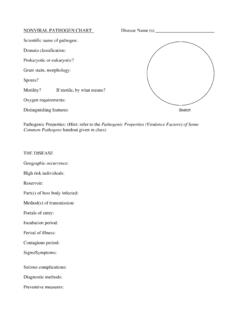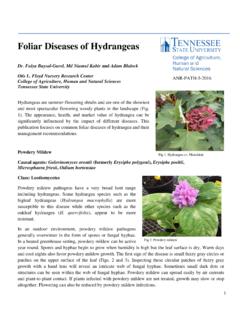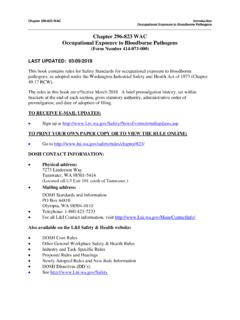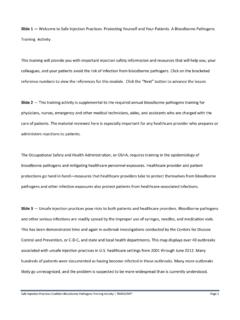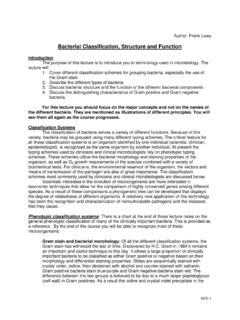Transcription of Pathogenic Properties (Virulence Factors) of Some Common ...
1 1 Pathogenic Properties ( virulence factors ) of Some Common pathogens Acinetobacter baumannii : Genus Acinetobacter is important opportunistic pathogens in hospital-acquired infections. They cause various types of human infections, including pneumonia, wound infections, urinary tract infections, bacteremia, and meningitis. Of the currently known 31 Acinetobacter species, Acinetobacter baumannii is the most prevalent in clinical specimens. Adherence of bacteria to epithelial cells is an essential step towards colonization and infection. Bacterial adherence to host cells is mediated by fimbria or membrane components. Furthermore, many Pathogenic bacteria are capable of invading non-phagocytic cells and evolve to survive within the host cells. The cellular invasion of bacteria contributes to evasion of humoral immunity, persistence in the host, and penetration into deep tissues. Arthropod-borne viral encephalitis: nerve cells in brain invaded and destroyed.
2 Bacillus anthracis: exotoxin causes swelling and hemorrhage of tissue and circulatory failure (septic shock) or fatal pneumonia. Bordetella pertussis: grows in upper respiratory tract, trachea and bronchioles; ciliary action slowed; toxins released cause death of epithelial cells. Borellia burgdorferi: immune response to presence of the bacteria causes tissue damage. Brucella spp.: organisms penetrate mucous membranes and are carried to heart, kidneys, and other organs; bacteria are resistant to phagocytic killing and grow in phagocytes. Campylobacter jejuni: multiplies within and beneath epithelial lining cells of intestine, causing inflammatory response and diarrhea. Rarely causes general paralysis (Guillain-Barre syndrome). Candida albicans: inflammatory response to overgrowth of the yeast that is normally present at low levels in normal flora. Chlamydophila psittaci: intracellular replication in cells of lungs causes pneumonia. Chlamydia trachomatis: intracellular replication causes death of host cells and formation of scar tissue Clostridium botulinum: multiplies in food and releases neurotoxin which, after ingestion, is carried to blood to motor nerves and blocks transmission of nerve impulses to muscles, producing flaccid paralysis.
3 Organism can also colonize intestine (in infants) and wounds, causing generalized weakness or paralysis. 2 Clostridium difficile: toxins kill intestinal epithelial cells and cause small patches called pseudomembranes, composed of dead epithelium, inflammatory cells, and clotted blood, to form on the intestinal wall. Clostridium perfringens: a) in gas gangrene: grows in dead and poorly oxygenated tissue, releases alpha-toxin that kills cells (b) in food poisoning: toxin causes abdominal cramps and watery diarrhea. Clostridium tetani: exotoxin acts against nerve cells that normally inhibit muscle contraction, causing constant contraction of muscle (state of tetanus). Coccidioides immitis: grows in lungs, inflammatory response damages tissue. Allergy to fungal antigens causes painful nodules and joint pain. Common cold viruses: viruses kill cells of upper respiratory epithelium. Corynebacterium diphtheriae: infection is in upper respiratory tract (often throat); exotoxin absorbed into blood, kills heart, kidney and nerve cells by blocking protein synthesis.
4 Cryptococcus neoformans: infection starts in lungs, disseminates via blood to meninges and other parts of body. Capsule inhibits phagocytosis. Cryptosporidium parvum: invades intestinal epithelial cells, causing inflammatory response. Secretion of water and electrolytes increases, absorption of nutrients decreases. Cytomegalovirus (CMV): damages many kinds of tissues, eyes, brain, liver. Latent infection can reactivate and cause tissue necrosis. Dengue viruses: target cells of viruses are monocytes and macrophages. First infection sets up immune response; in subsequent infection (with different strain of virus) antibodies promote viral uptake by macrophages. Death of macrophages releases chemicals that cause leaky capillaries and shock similar to a bacterial septic shock. May be fatal. Entamoeba histolytica: enzymes released allow penetration into intestinal wall and blood vessels, sometimes on to liver and other organs. Enterococcus faecium : colonizes the large intestines.
5 Risk factors for enterococcal infections are urinary or intravascular catheterization in addition to long-term hospitalization with broad-spectrum antibiotics. This bacterium has developed multidrug antibiotic resistance and uses colonization and secreted factors in virulence (enzymes capable of breaking down fibrin, protein and carbohydrates to regulate adherence, bacteriocins to inhibit competitive bacteria, for examples) 3 Epstein-Barr Virus (EBV): Infects epithelium of throat and salivary ducts, latent infection of B lymphocytes, rarely causes hemorrhage of enlarged spleen. Escherichia coli: release of toxins; invasion of tissue. In cystitis, bacteria attach by fimbriae to epithelium, cause inflammation and sloughing of cells. Can spread to kidneys by ureters, potential kidney failure. Francisella tularensis: disseminates throughout body by growing and traveling in phagocytes. Giardia lamblia: damages intestinal mucosa. Haemophilus influenzae: capsule prevents phagocytosis of bacterial cells.
6 Has specific adherence factors for conjunctiva (eye infection is pinkeye ). In meningitis, human inflammatory response causes swelling of brain Helicobacter pylori: organisms survive the acidity of stomach juices by producing a powerful urease. Upon reaching the layer of mucus, they penetrate to the epithelial surface, where bacterial products incite an inflammatory response. Thinning of the mucus layer occurs, and 10% to 20% of infected individuals develop ulcerations. Only a small percentage develop cancer, but more than 90% of individuals with stomach cancers are infected with this bacterium. Hepatitis viruses: destroy liver cells. Herpes simplex viruses: multiplies in epithelium, producing cell destruction and blisters. Persists in sensory nerves, reactivation stress-related. Histoplasma capsulatum: grows as yeast in lungs, multiplies in phagocytes, granulomas form, may disseminate in people with immune deficiency. Human Immunodeficiency virus (HIV): infects and kills CD4 lymphocytes and macrophages, slowly destroying ability of immune system to fight infections and cancers.
7 Human papillomaviruses: infect deep layer of epithelium; cancer-associated types integrate into host chromosome. Influenza viruses: Infection of respiratory epithelium. Cells destroyed. Secondary bacterial infection often follows. Klebsiella pneumoniae: colonization of alveoli stimulates inflammatory response; plasma, blood, and WBCs fill alveoli (pneumonia). Destruction of lung tissue and abscess formation, infection carried by blood to other organs. Legionella pnemophila: multiplies within phagocytes; death of these and other cells is followed by sloughing of cells lining the alveoli, tissue necrosis, and small abscesses. 4 Listeria monocytogenes: ingested cells penetrate intestinal mucosa and enter bloodstream, carried to meninges, causing meningitis; in pregnancy, crosses placenta and may fatally infect a fetus. Mumps: virus initially replicates in upper respiratory system, then disseminates to salivary glands and other organs. Inflammatory response to cell destruction causes swelling and pain.
8 Mycobacterium leprae: invasion of small nerves of skin, attack of immune cells against infected nerves produces nerve damage, leading to deformity; multiplies in macrophages. Mycobacterium tuberculosis: colonization of alveoli causes inflammatory response; organisms picked up by macrophages and carried alive to other body tissues. Neisseria gonorrhoeae: attach to epithelial cells by fimbriae (pili) that also block phagocytosis; causes inflammation and scarring. Neisseria meningitidis: adhere to upper respiratory tract by fimbriae (pili), enter bloodstream, carried to meninges and CSF, inflammation causes swelling that blocks drainage of CSF from brain, increased pressure impairs brain function, endotoxin release causes shock. Plasmodium spp.: infected RBCs rupture, releasing fever-causing toxins; infected RBCs stick to each other and to walls of capillaries; vessels plug up, depriving tissues of oxygen; spleen enlarges. Pneumocystis carinii: causes alveoli to fill with fluid, macrophages, and P.
9 Carinii; alveolar walls thicken, impairing gas exchange. Poliomyelitis (polio): first infects throat and intestine, enters motor neurons of brain and spinal cord, infected neurons lyse upon release of mature virus . Pseudomonas aeruginosa: releases multiple toxins and enzymes. Usually requires previously damaged tissue or impaired body defenses. Rabies virus: travels via nerves to central nervous system, damages neurons, spreads via nerves to heart and other organs. Rickettsia prowazekii: intracellular parasite in endothelial cells of arteries, veins, and capillaries. Causes blood clots that lead to gangrene of extremities, nose, ears and genitalia. Rickettsia rickettsii: infects and damages capillary walls, vascular lesions and endotoxin cause disease. 5 Ringworm fungi: enzyme keratinase dissolves keratin of skin, hair and nails. Rotaviruses: Infect epithelial cells that line upper part of small intestine, causing cell death and decreased production of digestive enzymes.
10 Rubella virus (German measles): virus first replicates in upper respiratory tract, disseminates to all parts of the body, crosses placenta, damages embryo or fetus. Rubeola virus (Measles): virus first multiplies in respiratory tract then carried by blood to skin, lung, brain. Secondary bacterial infection of lungs and ears. Possible brain damage. Salmonella enteritidis (Salmonella enterica serotype enteritidis) invades lining and wall of lower small intestine and large intestine; inflammatory response causes increased fluid secretion (diarrhea) Salmonella typhi (Salmonella enterica serotype typhi): multiples within macrophages, carried by blood throughout body, causes abscesses, septicemia, intestinal rupture and hemorrhage. Shigella spp.: invades and multiplies within intestinal epithelial cells, causing death of cells, intense inflammation, and ulcerations of intestinal lining Staphylococcus aureus: capsule (inhibits phagocytosis), coagulase (clots in capillaries keep away phagocytes),exfoliatin (scalded skin syndrome), hyaluronidase (spreads infection), leukocidin (kills WBCs) lipase (breaks down fats) proteases (degrade collagen and other tissue proteins, toxic shock syndrome toxin (causes rash, diarrhea, and shock by acting as a superantigen that causes cytokine release and low blood pressure), entertoxin (causes food poisoning), and other virulence factors .)
